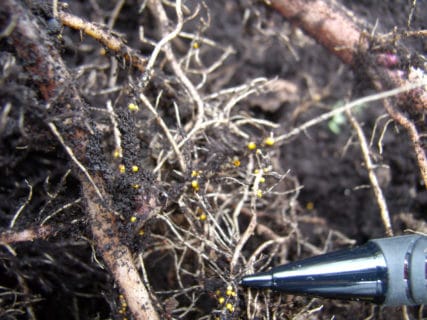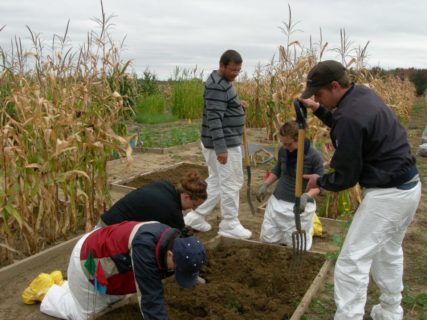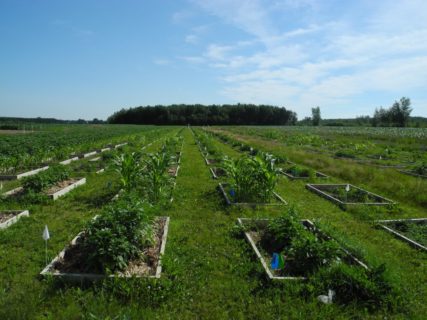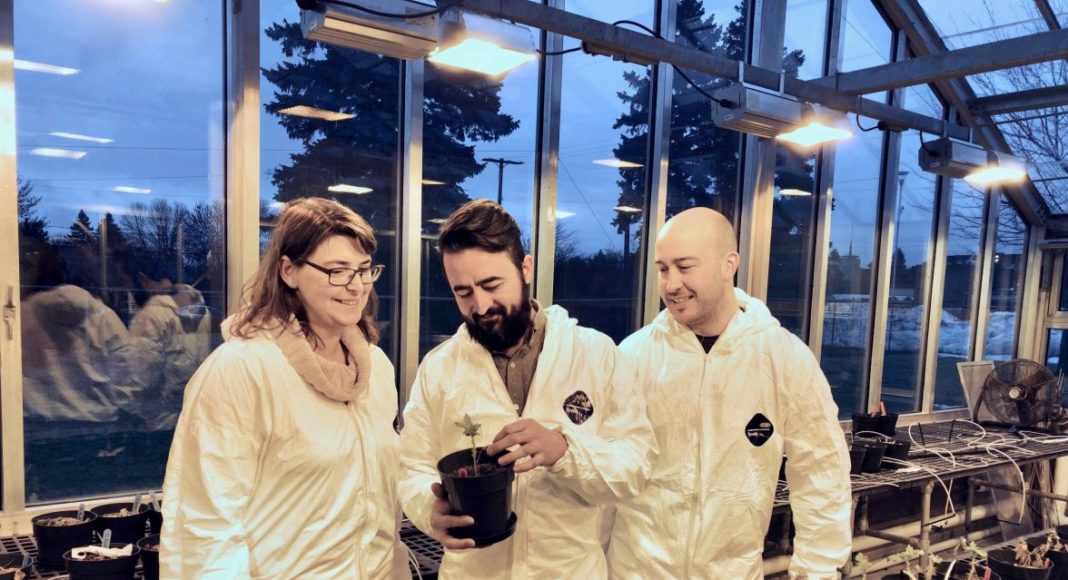[deck]With a multi-pronged effort, Quebec researchers are helping to advance monitoring and management of potato cyst nematodes.[/deck]
Although extremely rare in Canada, potato cyst nematodes (PCN) are such a serious risk to potato production and trade that the Canadian Food Inspection Agency (CFIA) has strict surveillance and quarantine protocols.
When PCN was discovered in Quebec in 2006, the CFIA immediately implemented quarantine measures for the affected fields. As well, the agency took other important steps, including working with Agriculture and Agri-Food Canada (AAFC) and other stakeholders to identify research needs for the Quebec situation.
Since then, AAFC’s many PCN discoveries have played a vital part in the efforts of the CFIA and growers to eradicate the pest in Quebec — efforts that have already made substantial progress. Today, PCN populations in most of the quarantined fields are near zero.
“Potato cyst nematodes are devastating pests for potatoes; economically they are probably at the top of the list [of serious potato pests]. If left uncontrolled, they can reduce yields by up to 80 per cent,”says Benjamin Mimee, a nematologist with AAFC at Saint-Jean-sur-Richelieu, Que.
He explains there aretwo species of these microscopic roundworms: the golden nematode, Globodera rostochiensis; and the pale cyst nematode, Globodera pallida. Both species attack the roots of host plants.
“The symptoms of PCN in potato plants are not specific and are not reliable for identification,” he says. “The main symptoms are poor growth, yellowing and wilting of the foliage, [and early death of the plant]. These symptoms can easily be mistaken for problems like water stress and mineral deficiencies, but the affected plants will be found in patches in the field, never uniformly over the entire field.”

Photo: Éléonore Tremblay/AAFC
The cysts are the most distinctive PCN symptom. “At the end of the season, if you dig up an infested plant with a trowel and remove the soil, you’ll be able to see the cysts on the roots,” says Mimee.
The cysts are actually the dead bodies of the female nematodes, which contain the eggs. The cysts help protect the eggs from environmental stresses. Each cyst contains hundreds of eggs.
Host plants release chemical cues from their roots that cause the eggs to hatch. After hatching, the juveniles swim to the nearby host plant and enter the root to feed. After several growth stages, the worm-like males leave the root while the spherical females remain inside the root. The females grow and break through the root so that their reproductive parts protrude beyond the root.
After mating, the males soon die, while the females swell as the eggs form inside them. The females die in place about when the potato crop is flowering. In golden nematodes, the cysts change from white to yellow to gold and then brown. In pale cyst nematodes, the cysts change from white or a cream colour to brown.
“PCN are very hard to manage because, first of all, the eggs are protected inside the cysts so they are relatively resistant to pesticides. Also, they only hatch in the presence of potatoes or certain other plants in the Solanaceae family, like tomatoes, eggplants and some nightshade weeds. If no host plants are grown in a field, the eggs can survive for decades; survival for more than 30 years has been reported.”
PCN are typically spread from place to place by the movement of infested soil on seed potatoes, equipment, machinery and containers. If a grower suspects he may have PCN in his field, he must immediately report the situation to the local CFIA office and cease all activities that could move soil from the suspect field to the rest of the farm. For more information, visit CFIA’s website (www.inspection.gc.ca).
The Canadian Situation
PCN have been confirmed in 65 countries, including Canada and the United States. “In Canada, PCN have been known for a long time, but for many years they were limited to two islands — Vancouver Island and Newfoundland. In Newfoundland, the golden nematode was detected around 1962 and the pale cyst nematode in 1977. Strict measures were already in place on Newfoundland to prevent soil movement because of potato wart. To our knowledge, these measures were effective at preventing the spread of these populations,” says Mimee.
“On Vancouver Island, the golden nematode was detected in 1965. It may have arrived on infested flower bulbs from Europe. Quarantine measures were put in place including a complete ban on the cultivation of potatoes in the affected fields. These measures successfully controlled the spread of PCN.”
The Newfoundland and Vancouver Island quarantines are still in effect. After 1977, no new Canadian PCN detections occurred until the golden nematode was found in 2006 in the town of Saint-Amable in southwestern Quebec.
“Following the initial discovery in 2006 in Quebec, the CFIA intensively sampled to find any other infested fields. They established a quarantine status on 4,750 hectares of land, including the entire town of Saint-Amable,” he says.
“In the regulated fields, the required measures include sanitation of all machinery and equipment before exiting the regulated fields, and a complete ban on the cultivation of any host plants.” Although fumigation was used for the Vancouver Island situation, it is not suitable for the Quebec location because it is in a residential area and has a high water table.
“Unlike B.C., the growers in Quebec are allowed to grow PCN-resistant potato varieties, but they can only grow them one year out of three. The other two years in the rotation must be non-host crops. The growers must also wash the tubers and other root vegetables grown in those fields before the vegetables are packaged and exit the regulated area.”
Best Control Option
AAFC’s field studies on PCN take place within the regulated area. One of those studies evaluated options for controlling golden nematodes under Quebec conditions. These options included: growing a resistant potato variety, growing non-host crops, trap cropping, growing a non-host nightshade weed, and applying soil amendments such as chicken manure, pig slurry or high rates of urea.
“We learned two main things from this research. First, there is no miraculous solution for PCN, so we have to live with the problem,” Mimee says.
“Second, we showed that resistant cultivars are highly effective against the golden nematode. Of all the management options that we tried, they were by far the most effective.”

Photo: Nathalie Dauphinais/AAFC
Like susceptible potato plants, the resistant varieties release compounds that induce nematode hatching, but the juveniles can’t feed on the resistant plant so they die. “Our research shows that growing resistant potatoes will kill around 70 per cent of the nematode population in a year. After three consecutive years of cropping with resistant potatoes, viable PCN were barely detectable in the field,” he says.
In contrast, non-host plants do not induce hatching. “Natural population decline with a non-host crop was about 30 per cent per year.” The other treatment options were not only less effective than growing resistant cultivars, but some were much more expensive, impractical and/or noxious.
PCN-resistant varieties are also the best option for growers in economic terms. So far, the CFIA has approved 71 golden nematode-resistant varieties for cultivation.
On the Watch for Virulence
The golden nematode has several strains, or pathotypes. The Quebecinfestation is pathotype Ro1 (‘Ro’ for rostochiensis). “For the golden nematode, most of the resistant cultivars rely only on the H1 gene. This resistance gene is highly effective against Ro1. But as with any resistance gene, it can be overcome, and this has already happened in New York State and Europe,” says Mimee.
“An organism can overcome resistance in two ways. One is through spontaneous mutation, which is a natural phenomenon, but this process is extremely slow. The other is through the introduction of a population that is already virulent,” he explains.
“At Saint-Amable, we have no signs of a virulent population. Under controlled conditions, we exposed a field population of PCN to five continuous years of resistant potatoes and we didn’t find any nematodes multiplying.” Even if a few virulent individuals have been introduced, Mimee thinks it would probably take decades for a virulent population to build up, given the current crop rotation of one year of potato out of three years.
In addition, he points out, “The breeding program at Cornell University has just released two new cultivars that are also resistant to Ro2 [the other golden nematode pathotype in North America].”
Currently, to determine if a golden nematode population is a virulent pathotype, it has to be tested on plants in a specialized greenhouse with a quarantine protocol, and the test takes about four months. AAFC researchers are now developing molecular tools to determine the pathotype in just a few hours.
Climate Change Concerns
Mimee and his team have examined the golden nematode’s life cycle under the growing conditions in southwestern Quebec. That information is important for control measures like trap cropping because the trap crop has to be destroyed before the nematodes complete their life cycle.
In the AAFC study of control measures, trap cropping was the second-most-effective option. “If in the future we find other golden nematode pathotypes or the pale cyst nematode, then trap cropping could be a good control method.” Trap cropping is used in Europe and Idaho, which have the pale cyst nematode.
“The most striking result from our life cycle work was the observation that a second generation of mature males was possible in a single growing season,” says Mimee.
“It has generally been shown that in temperate regions the nematode can only complete one generation per year. But we have shown in warmer years a second generation could be possible if late-maturing potatoes are grown. In light of climate change, this could be bad news for PCN management.”
Quarantine Effectiveness
Mimee and his research team have also developed and published a more accurate way to measure the nematode’s population levels in the soil. Such accuracy is critical for tracking the effectiveness of control measures and to help determine when a quarantined field can be deregulated.
“Currently, the diagnostic labs, including the CFIA’s lab, only report the PCN population density in terms of the number of cysts per gram of soil. However, when you grow resistant potatoes, the nematodes will hatch and die, but the empty cysts stay in the soil,” explains Mimee.
The new method measures the number of viable eggs. “We have shown that during five years of growing resistant potatoes, the number of cysts will not change but the number of viable eggs will drop by more than 99.9 per cent. We think that this analysis should be included in routine testing to better reflect the PCN population density in the field.”
According to Mimee, the CFIA has submitted a proposal for funding to assess this new method in the high-throughput conditions at the agency’s lab. He will also be discussing the method with the U.S. Department of Agriculture.
Measurements of the number of viable eggs prove that the quarantine measures in Quebec are very effective. “After 10 years of quarantine procedures, the number of viable eggs was barely detectable in most of the fields that we have tested. This is excellent news. And the quarantine has certainly contributed to limiting the spread of PCN to other potato-growing regions,” says Mimee.
Since 2006, Canada and the United States have had an agreement that harmonizes their PCN strategies. As part of these strategies, each country conducts national surveys involving soil sampling and testing for PCN in all fields where seed potatoes are produced for trade between the two countries.
Mimee’s team has developed a better way to do the sampling for these surveys. The new method involves collecting the soil under the conveyors used to transfer potatoes to storage, so it is less labour-intensive and less expensive than scouting and collecting soil samples within a field.
New Genomic Insights
Mimee is a member of the Globodera Alliance, or GLOBAL (globodera.org), an international group of research, extension and education professionals focusing on PCN management and eradication. As part of this effort, Mimee and his colleagues have developed a method to genotype and compare more than 100 different PCN populations from around the world. This research is shedding light on the international routes of PCN introduction and the development of different pathotypes in different regions.
Mimee was part of the international team that recently sequenced the golden nematode’s genome. “Next-generation sequencing has opened huge possibilities in research not only for PCN but for all areas of biological research. For PCN, the sequencing of the genome is helping us to understand how the nematode has acquired its capacity to infect potatoes. We have already shown that some of the proteins necessary for infection were actually transferred from other microbes like bacteria and fungi,” he says.

Photo: Nathalie Dauphinais/AAFC
“Beyond this basic knowledge of PCN’s evolution, this sequencing greatly facilitates the development of diagnostic markers and opens the way for the development of new management options. For example, we have identified the genes involved in the very, very early steps of hatching. If we can trigger the expression of these genes in [a field with no host plants], then all the nematodes would hatch and die. It also seems that many virulence genes could be under the control of similar promoters. If we can switch off these genes, then the nematode will not be infective anymore.”
As well, Mimee’s research team is completing a comparison of various Globoderaspecies, some that infect potatoes and some that don’t. “We want to understand how some have lost or gained the ability to infect potato. This knowledge could open the way for new management tools that would be effective against all the species and all the pathotypes of PCN,” says Mimee.
AAFC’s PCN research is providing results with immediate practical applications and it is contributing to new knowledge that will help in developing practical advances in the years ahead.











